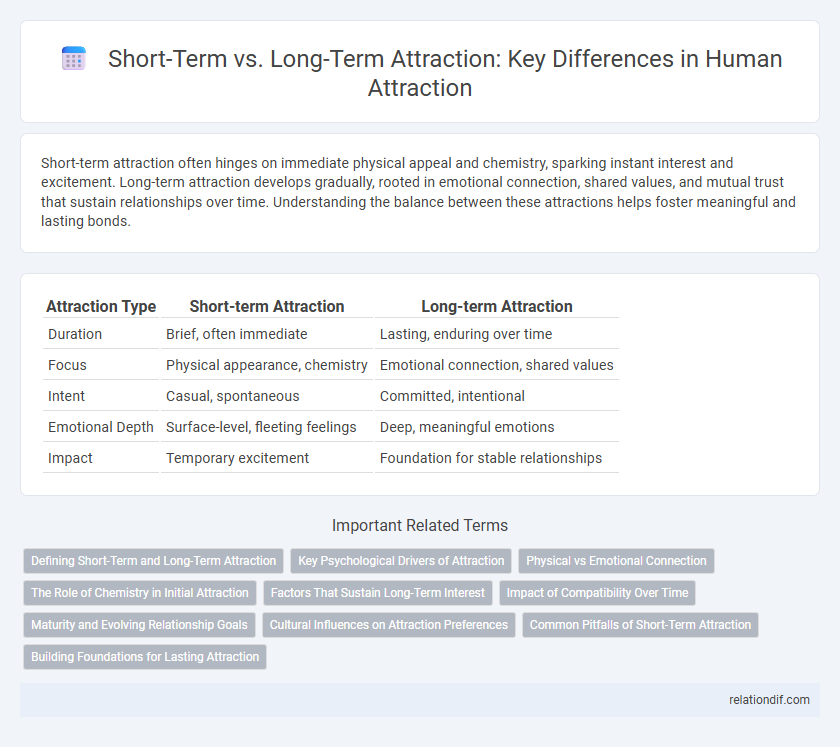Short-term attraction often hinges on immediate physical appeal and chemistry, sparking instant interest and excitement. Long-term attraction develops gradually, rooted in emotional connection, shared values, and mutual trust that sustain relationships over time. Understanding the balance between these attractions helps foster meaningful and lasting bonds.
Table of Comparison
| Attraction Type | Short-term Attraction | Long-term Attraction |
|---|---|---|
| Duration | Brief, often immediate | Lasting, enduring over time |
| Focus | Physical appearance, chemistry | Emotional connection, shared values |
| Intent | Casual, spontaneous | Committed, intentional |
| Emotional Depth | Surface-level, fleeting feelings | Deep, meaningful emotions |
| Impact | Temporary excitement | Foundation for stable relationships |
Defining Short-Term and Long-Term Attraction
Short-term attraction often centers on immediate physical appeal and intense emotional excitement, driven by novelty and chemistry. Long-term attraction develops through deeper emotional connection, shared values, trust, and commitment, building a foundation for lasting relationships. Understanding these distinctions helps clarify motivations and expectations in different types of interpersonal connections.
Key Psychological Drivers of Attraction
Short-term attraction is primarily driven by physical appearance, novelty, and immediate emotional arousal, activating brain regions associated with reward and dopamine release. Long-term attraction relies on deeper psychological drivers such as emotional intimacy, trust, and shared values, which engage areas of the brain linked to attachment and oxytocin production. Understanding these key psychological mechanisms helps explain how initial excitement transitions into sustained relational bonds.
Physical vs Emotional Connection
Short-term attraction often hinges on physical appearance and immediate sensory appeal, triggering instinctual responses and desire. Long-term attraction prioritizes emotional connection, trust, and compatibility, fostering deeper bonds beyond surface-level traits. The balance between physical and emotional factors determines the sustainability and depth of romantic relationships.
The Role of Chemistry in Initial Attraction
Short-term attraction is often driven by intense chemistry that sparks immediate physical and emotional responses, typically fueled by novelty and high dopamine levels in the brain. Long-term attraction, however, relies on deeper emotional bonds, shared values, and sustained compatibility beyond initial chemical reactions. Understanding the neurochemical role of serotonin, oxytocin, and dopamine explains why initial chemistry can ignite desire but must evolve into trust and connection for lasting relationships.
Factors That Sustain Long-Term Interest
Long-term attraction relies heavily on shared values, emotional intimacy, and consistent communication, which foster trust and deeper connection over time. Mutual respect and aligned life goals play critical roles in sustaining long-term interest beyond initial physical or superficial appeal. Regularly investing in emotional support and personal growth together ensures the relationship remains dynamic and fulfilling.
Impact of Compatibility Over Time
Short-term attraction often relies on immediate chemistry and physical appeal, creating a strong initial connection that can be intense but fleeting. Long-term attraction is deeply influenced by compatibility factors such as shared values, communication styles, and emotional support, which sustain the relationship through evolving life circumstances. Research shows couples with high compatibility experience greater relationship satisfaction, stability, and resilience against stress over time.
Maturity and Evolving Relationship Goals
Short-term attraction often highlights initial physical appeal and immediate excitement, reflecting less emphasis on maturity. Long-term attraction prioritizes emotional depth, shared values, and evolving relationship goals that align with personal growth and mutual support. Maturity fosters understanding and adaptability, essential for sustaining connection as priorities and circumstances change over time.
Cultural Influences on Attraction Preferences
Cultural influences shape short-term attraction by emphasizing physical appearance and social status as immediate indicators of desirability. In contrast, long-term attraction preferences often reflect cultural values such as family orientation, emotional stability, and shared beliefs, which foster deeper connections. Understanding these cultural distinctions enhances insight into how attraction evolves within diverse societies.
Common Pitfalls of Short-Term Attraction
Short-term attraction often hinges on physical appearance and immediate gratification, leading to superficial connections that lack emotional depth. Common pitfalls include misinterpreting lust for genuine compatibility and overlooking important values or personality traits essential for long-term relationship success. This shortsightedness can result in unstable relationships and unmet expectations, highlighting the necessity of assessing shared goals and emotional bonding beyond initial attraction.
Building Foundations for Lasting Attraction
Short-term attraction often hinges on physical appearance and immediate chemistry, creating an intense but fleeting connection. Long-term attraction develops through shared values, emotional intimacy, and trust, laying a strong foundation for enduring relationships. Building lasting attraction requires consistent communication, mutual respect, and emotional support that deepen the bond over time.
Short-term attraction vs Long-term attraction Infographic

 relationdif.com
relationdif.com